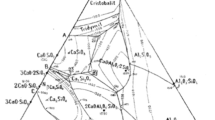Abstract
The present paper contains an analysis of alternative functions to describe chemical equilibrium. In particular we show the equivalence of equilibrium criteria based on pressure, volume and temperature, and corresponding constraints, with respect to those popularly used in thermodynamics, i.e. those based on the minimization of internal energy, enthalpy, Helmholtz and Gibbs potentials. The analysis emphasizes the role of mathematical virtual procedures in determining the equilibrium conditions and the irrelevance of physico-chemical transformations that bring the system into the equilibrium state. Different examples, including a new derivation of Saha’s equation, are dealt with to validate this conceptual approach.
Similar content being viewed by others
References
I. M. Klotz R.M. Rosenberg (1986) Chemical Thermodynamics Benjamin Menlo Park, CA
P. W. Atkins (1986) Physical Chemistry Oxford Univ.Press Oxford England, UK
G. K. Vemulapalli (1993) Physical Chemistry Prentice Hall, Inch. Englawood Cliffs, New Jersey, USA
D. Giordano (1998) Phys Rev. E58 3098 Occurrence Handle1998PhRvE..58.3098G
R. A. Alberty (2001) Pure Appl. Chem. 73 1349
R. A. Alberty I. Oppenheim (1988) J. Chem. Phys. 89 3689 Occurrence Handle10.1063/1.454889 Occurrence Handle1988JChPh..89.3689A
H. Callen (1985) Thermodynamics and an Introduction to Thermostatics John Wiley New York
J. W. Gibbs, On the Equilibrium of Heterogeneous Substances, Trans. of the Connecticut, Academy, Vo1. 3, p. 108, 343(1876) (see also the Scientific Papers of J. W. Gibbs: Thermodynamics, Ox Bow, Woodbridge, Ct), 1993 p. 88.
H. Margenau G. Murphy (1959) The Mathematics of Physics and Chemistry Van Nonstrand Princeton, NJ 14
M. Capitelli D. Giordano (2002) J. Thermophy. Heat Transfer 16 283
Minimization (Min) and maximization (Max) of the relevant equations depends on the sign appearing before the term ∑ μ i dN i . This point can be also understood taking into account the inequality nature of Eq. (1) from classical thermodynamics. As an example Eq. (3) can be written as (dG) ≤ Vdp − SdT + ∑μ i dN i implying (dG) p,t ≤ ∑μ i dN i ≤ 0 Min; (dp) g,t ≥ ∑μ i dN i ≥ 0 Max; (dT) g,p ≤ ∑μ i dN i ≤ 0 Min. In this context we note that the inequality for the volume without the chemical term i.e. \(dV\leq {TdS \over p}-{dV \over p}\) was first derived by Maxwell as reported by L. C. Wood Thermodynamic Inequalities in Gases and Magnetoplasmas, J. Miley, New York 1995.
Note the second member of Eqs. (17) and (18) of Ref. 10 should be divided by RT.
D. Giordano M. Capitelli (2001) Phys. Rev. E 65 016401 Occurrence Handle2002PhRvE..65a6401G
M. Lisal W. R. Smith I. Herbeda (2000) J. Chem. Phys. 113 4885 Occurrence Handle2000JChPh.113.4885L Occurrence Handle10.1063/1.1289245
H. Reiss, Methods of Thermodynamics, Dover Publications (1965).
A. Appleton (1990) Eur. Phys. J. 11 297
D. Kondepudi and I. Prigogine, Modern Thermodynamics (1998), J. Wiley and Son Ltd.
M. Capitelli R. Celiberto S. Longo (2001) Foundations of Chemistry: Thermodynamics and Chemical Kinetics (in Italian) Adriatica Editrice Bari Italy
Author information
Authors and Affiliations
Corresponding author
Additional information
This paper is dedicated to the memory of one of the authors, Giuseppe Petrella, who unfortunately is not with us any more.
Rights and permissions
About this article
Cite this article
Capitelli, M., Longo, S., Petrella, G. et al. Equivalent Potential Functions to Calculate Thermodynamic Equilibria*. Plasma Chem Plasma Process 25, 659–675 (2005). https://doi.org/10.1007/s11090-005-6819-7
Received:
Revised:
Issue Date:
DOI: https://doi.org/10.1007/s11090-005-6819-7




